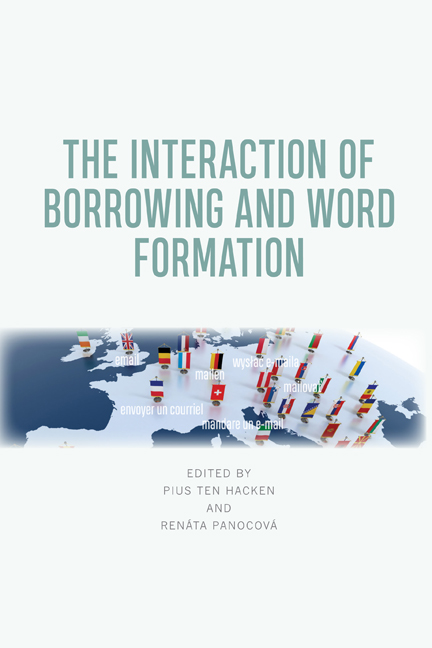Book contents
- Frontmatter
- Contents
- List of Figures and Tables
- List of Contributors
- Preface
- List of ISO-639 Language Codes
- Introduction
- 1 Word Formation, Borrowing and their Interaction
- Part I Compounding
- 2 Compounding and Contact
- 3 Neoclassical Compounds between Borrowing and Word Formation
- 4 Borrowed Compounds, Borrowed Compounding – Portuguese Data
- 5 Compound Calques in an Eighteenth-Century German-Lithuanian Dictionary
- 6 (Pseudo-)Anglicisms as Nominal Compounds in Italian
- Part II Affixation
- 7 The Role of Borrowing in the Derivation of Passive Potential Adjectives in Polish
- 8 How an ‘Italian’ Suffix Became Productive in Germanic Languages
- 9 The Suffixes -ismus and -ita in Nouns in Czech
- 10 The Interaction between Borrowing and Word Formation: Evidence from Modern Greek Prefixes
- Part III Naming in Minority Languages
- 11 Loanword Formation in Minority Languages: Lexical Strata in Titsch and Töitschu
- 12 Examining the Integration of Borrowed Nouns in Immigrant Speech: The Case of Canadian Greek
- 13 Interaction among Borrowing, Inflection and Word Formation in Polish Medieval Latin
- Conclusion
- 14 Trends in the Interaction between Borrowing and Word Formation
- Author Index
- Subject Index
12 - Examining the Integration of Borrowed Nouns in Immigrant Speech: The Case of Canadian Greek
Published online by Cambridge University Press: 22 September 2020
- Frontmatter
- Contents
- List of Figures and Tables
- List of Contributors
- Preface
- List of ISO-639 Language Codes
- Introduction
- 1 Word Formation, Borrowing and their Interaction
- Part I Compounding
- 2 Compounding and Contact
- 3 Neoclassical Compounds between Borrowing and Word Formation
- 4 Borrowed Compounds, Borrowed Compounding – Portuguese Data
- 5 Compound Calques in an Eighteenth-Century German-Lithuanian Dictionary
- 6 (Pseudo-)Anglicisms as Nominal Compounds in Italian
- Part II Affixation
- 7 The Role of Borrowing in the Derivation of Passive Potential Adjectives in Polish
- 8 How an ‘Italian’ Suffix Became Productive in Germanic Languages
- 9 The Suffixes -ismus and -ita in Nouns in Czech
- 10 The Interaction between Borrowing and Word Formation: Evidence from Modern Greek Prefixes
- Part III Naming in Minority Languages
- 11 Loanword Formation in Minority Languages: Lexical Strata in Titsch and Töitschu
- 12 Examining the Integration of Borrowed Nouns in Immigrant Speech: The Case of Canadian Greek
- 13 Interaction among Borrowing, Inflection and Word Formation in Polish Medieval Latin
- Conclusion
- 14 Trends in the Interaction between Borrowing and Word Formation
- Author Index
- Subject Index
Summary
In virtually every country in the world linguistic minorities can be found as a result of immigration. In this context, linguistic interaction and contact-induced changes are apparent in the speech of immigrants and borrowing emerges as the outcome of language contact, leading to the transfer of various lexical elements, features and structures (see, among others, Haugen 1950; Poplack 1980; Poplack et al. 1988; Poplack et al. 1990; Sankoff et al. 1990; Myers-Scotton 2002; Clyne 2003).
This chapter is concerned with the speech of first-generation Greek immigrants who arrived in Canada in the period between 1945 and 1975, which has seen the bulk of Greek emigration. It scrutinises how the Greek language has evolved in a language contact situation, where English is the donor and Greek the recipient. In spite of the great interest this contact situation presents, it remains largely unexplored. In fact, this chapter constitutes one of the first attempts to investigate aspects of borrowing in the language of Greek immigrants in Canada and aspires to contribute to the study of immigrant speech in general. It aims to bring into focus the ways in which Greek immigrants resort to lexical transfer by mixing and blending Greek and English. It shows that there is a creative playing with resources spanning these two languages, in a way that underscores the linguistic resourcefulness of the speakers themselves as agents of innovations spread throughout the linguistic community. The end product of contact between Canadian English and Greek shows language-internal constraints of the recipient language that are uninterruptedly at work throughout the process of the integration of borrowed words (see also Hock and Joseph 2009 and Baran 2017 on this matter).
In order to show this, an answer is attempted to a series of general research questions, such as:
What are the various types of linguistic practices with regard to borrowed words, as they are materialised in the process of their integration in the Canadian Greek transplanted communities?
Is the typological distance between the analytic English and the fusional Greek an inhibitor in borrowing?
Could specific types of integration be attributed to specific properties of the languages in contact?
- Type
- Chapter
- Information
- The Interaction of Borrowing and Word Formation , pp. 237 - 258Publisher: Edinburgh University PressPrint publication year: 2020



